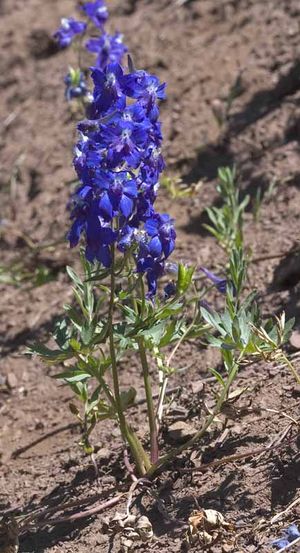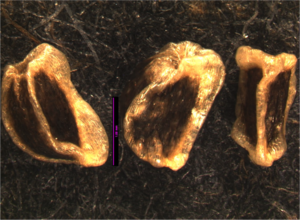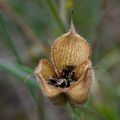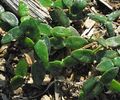Delphinium menziesii
- Scientific Name: Delphinium menziesii
- Family: Ranunculaceae
- Common Names: Menzie's larkspur
- Codon: DELMEN
Contents
Taxonomy
| Scientific classification | |
|---|---|
| Kingdom: | Plantae |
| Subkingdom: | Viridiplantae |
| Phylum: | Tracheophyta |
| Subphylum: | Spermatophytina |
| Class: | Magnoliopsida |
| Subclass: | Magnoliidae |
| Order: | Ranunculales |
| Family: | Ranunculaceae |
| Genus: | Delphinium L. |
| Species: | Delphinium menziesii DC. |
| Synonyms | |
| |
Description
Perennial herb with spurred, bluish-purple flowers growing from tuberous roots, up to 50 cm tall.[2] Stems unbranched, with fine hairs.[3] Leaves alternate,[4] dissected 2-3 times, narrowly oblong, basal leaves long-petiolate.[2] Inflorescences open-racemose, simple to compound, 3-20 flowered.[2] Flowers zygomorphic; sepals 5, uppermost being prominently spurred; corolla with two unequal pairs (4 petals), upper pair spurred, lower pair dark blue to purple; many stamens;[4] pistils 3, simple, becoming 3 follicles.[2]
Bloom Period
April-July[2]
Distribution
Both sides of the Cascades in Washington, British Columbia to Oregon.[5]
Habitat
Prairies, coastal bluffs, mid-elevation moist meadows and forest openings.[2] Delphinium menziesii occurs in rich well drained soils and full sun.[6]
Uses
POISONOUS PARTS: All parts. Highly Toxic; May be Fatal if eaten. Symptoms include burning of lips and mouth, numbness of throat; intense vomiting and diarrhea, muscular weakness and spasms, weak pulse, paralysis of the respiratory system, convulsions. Toxic Principle: Alkaloids delphinine, ajacine, and others. (Poisonous Plants of N.C.). Inhibits the growth of nearby plants, especially legumes.[6]
The First Nations have recorded uses of Dephinium menziesii as a poultice of the stalks and roots that has been applied to sores. A parasiticide is obtained from the leaves. It is quite toxic and so is for external use only. A blue dye can be obtained from the flowers.[7]
Gardeners purport that this plant is an attractant and pollinated by hummingbirds, butterflies and bumblebees.[8]
Propagation
Sow seeds in March/April in a cold frame or May outdoors. Keep moist and in a shady position until germination takes place. The seed has a limited viability so it should be stored in a sealed container at about 3°c. Temperatures above 15°c inhibit germination. The seed usually germinates in 2 - 9 weeks at 15°c. When they are large enough to handle, prick the seedlings out into individual pots and plant them out into their permanent positions in the summer. Cuttings of basal shoots in April/May, taken before they become hollow at the base, and planted in a cold frame. Division in spring or early autumn.[6]
Native Plant Network Propagation Protocol
Seed
Seed sample from 2009
Features
Average measurement: 1.9 x 1.2 x 1
Measurement range: L: 1.5 – 2.3, W: 1.1 – 1.3, D: 0.9 x 1.2
Latitudinal cross section: obovate ![]()
Longitudinal cross section: elliptical ![]()
Seeds dark brown in a roomy, clear/white seed coat that bunches around hilum and seed edges. Bagginess of seed coat sometimes gives the seed a winged appearance.
Seed coat very finely longitudinal striate and glossy.
Basic Explanations and Assumptions:
The dimensions for the seeds are length x width x depth. The location of the hilum is used as the base of the seed, and the length is measured from hilum to the opposite apex. Where a style is present, the length is measured from the hilum to the bottom of the style. Width is measured at a right angle to the length at the widest part. Depth is measured at a right angle to the intersection of height and width lines.
Measurements included are the mean average for each measurement of ten separate seeds.
All measurements in millimeters unless otherwise noted.
Photo Gallery
References
- ↑ Integrated Taxonomic Information System. Retrieved from https://www.itis.gov/servlet/SingleRpt/SingleRpt?search_topic=TSN&search_value=18478
- ↑ 2.0 2.1 2.2 2.3 2.4 2.5 WTU Herbarium, Burke Museum, & University of Washington. Retrieved from https://biology.burke.washington.edu/herbarium/imagecollection/taxon.php?Taxon=Delphinium%20menziesii
- ↑ Pojar, J., & MacKinnon, A. (1994) Plants of the Pacific Northwest Coast. Lone Pine Publishing.
- ↑ 4.0 4.1 Hitchcock, C. L., Cronquist, A., Giblin, D., & Legler, B. et al. (2018). Flora of the Pacific Northwest: an illustrated manual. Seattle: University of Washington Press. p. 89-92.
- ↑ WTU Herbarium, Burke Museum, & University of Washington. Retrieved from http://biology.burke.washington.edu/herbarium/imagecollection/browse.php?Genus=Delphinium
- ↑ 6.0 6.1 6.2 Plants for a Future. Retrieved from https://pfaf.org/user/Plant.aspx?LatinName=Delphinium+menziesii
- ↑ Native American Ethnobotany Database. Retrieved from http://naeb.brit.org/uses/search/?string=delphinium+menziesii
- ↑ Walama Restoration Project. Retrieved from https://walamarestoration.org/wp-content/uploaded/Fall-12-Newsletter-pdf.pdf





